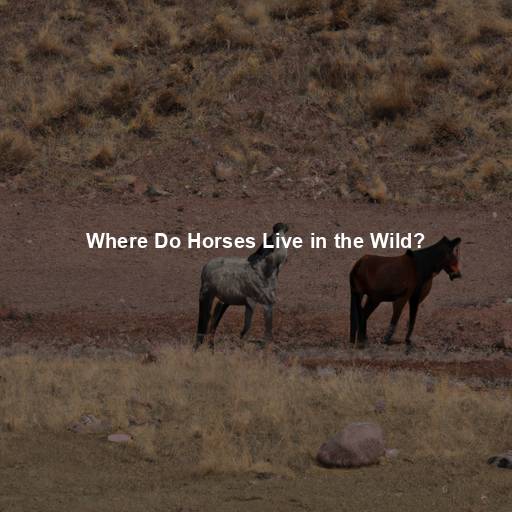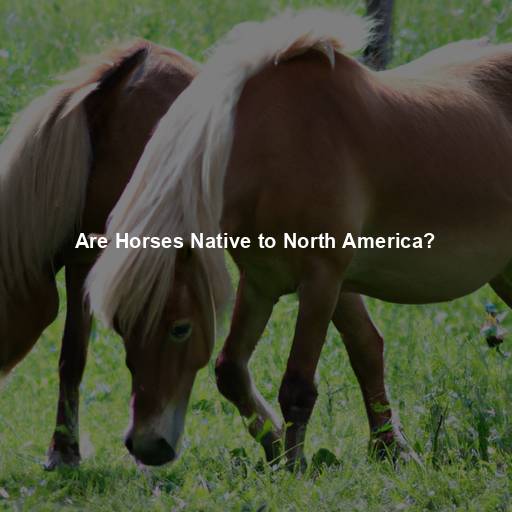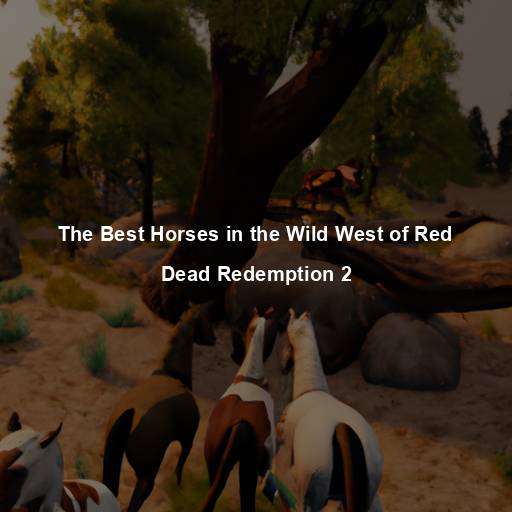Where Do Horses Live in the Wild?
Last Updated on November 20, 2023 by Evan
For centuries, the allure of horses has bewitched us with their majestic presence, a blend of strength, elegance, and sheer beauty. The untamed spirit they exude when galloping across vast plains or peacefully grazing in lush meadows fuels our fascination with these magnificent creatures. Join us as we embark on an extraordinary expedition, unraveling the mysteries of wild horses, their intricate behaviors, remarkable adaptations, and the daunting obstacles they confront in the untamed wilderness. Prepare to be captivated as we delve into the enchanting realm of these mesmerizing creatures, venturing into the very heart of the places they call home.
Contents
The Diverse Habitats of Wild Horses
From the sprawling plains of North America to the majestic peaks of Asia, the untamed spirit of wild horses knows no bounds. Thriving against the odds, these magnificent creatures have mastered the art of survival in their own distinct landscapes. Embark on a journey with us as we unveil the mysterious habitats that serve as the canvas for their beguiling existence. Delve into the bursting energy of the untamed grasslands and the perplexing ruggedness of the mountainous realms where these ethereal beings roam with grace, defying the very limits of nature itself.
The American West: The Iconic Home of Wild Mustangs
There is something undeniably captivating about the untamed spirit of wild horses, as they gallop freely through the expansive landscapes of the American West. In the vast expanse of arid plains, rolling hills, and rugged canyons, these iconic mustangs find solace and survival. Hailing from states like Nevada, Wyoming, and Montana, these magnificent creatures have carved out their own untamed existence, thriving amidst abundant grasses and boundless open spaces. They roam fearlessly, forming intricate herds, their hooves pounding the earth in a dance of grace and wildness.
The Steppes of Mongolia: Pristine Wilderness for Przewalski’s Horses
In the remote and untamed landscapes of Mongolia, the endangered Przewalski’s horses find solace. These unique wild horses, considered the only surviving species of truly wild horse, have adapted to the harsh conditions of the Mongolian steppes. From the windswept grasslands to the frigid winters, Przewalski’s horses have developed hardy physiques and a strong social structure to withstand the challenges of their habitat.
The Australian Outback: Brumbies Roaming the Land Down Under
Australia, known for its diverse wildlife, is also home to a population of wild horses called brumbies. Descendants of horses brought to the continent by European settlers, brumbies have thrived in the rugged terrain of the Australian Outback. From the arid deserts to the dense forests, these tenacious horses have adapted to the harsh climate and scarcity of water, forming small herds and exploring the vast expanse of the land.
The Camargue Region: Wetlands and White Horses
Nestled in the southern part of France, the Camargue region provides a unique and picturesque habitat for wild horses. Here, in the expansive wetlands and marshes, the famous Camargue horses roam freely. Known for their striking white coats and sturdy physique, these horses have adapted to the environment’s challenges, including the brackish water and seasonal flooding. The Camargue horses have become an integral part of the region’s culture and are celebrated in local traditions.
Behaviors and Adaptations of Wild Horses
Step into the awe-inspiring world of wild horses, where survival is an art mastered through remarkable behaviors and unparalleled adaptations. These stunning creatures have honed their skills to dance harmoniously with the untamed wilderness that surrounds them. Get ready to embark on a captivating journey as we unravel the secrets behind their fascinating traits that make them true masters of their untamed realms. The enigmatic habits of wild horses are bound to leave you breathless, igniting a sense of wonder that can only be found in nature’s most perplexing creations.
Social Structure and Herd Dynamics
In the untamed realm of nature, an enchanting creature known as the wild horse reigns supreme. They are not solitary wanderers, but rather, they thrive in the embrace of close-knit family circles known as herds. At the heart of these formidable groups stands a noble stallion, whose ardent duty is to safeguard his tribe with unwavering determination. Mares and their cherished offspring form an unbreakable alliance, forging unyielding connections founded on loyalty and interdependence.
Adaptations for Foraging and Grazing
Witness the awe-inspiring sight of majestic wild horses as they roam freely in their natural habitats. These captivating creatures have honed their survival skills over generations, adapting to a diet predominantly consisting of nutrient-rich grasses and vegetation. Their remarkable teeth and specialized digestive systems enable them to extract maximum nutrition from their forage, ensuring their vitality in even the most challenging environments. Marvel at their relentless determination as they traverse great distances in their quest for sustenance, a testament to their resilience in the face of limited resources.
Mobility and Speed
Wild horses, captivating creatures of unparalleled grace and untamed spirit, possess an innate nimbleness and swiftness that is crucial to their very existence. With their elongated limbs and robust musculature, these majestic beings effortlessly traverse a myriad of challenging landscapes, whether it be the treacherous cliffs of lofty mountains or the vast expanses of uncharted plains. It is through this unparalleled mobility that they elude the clutches of predators, uncover life-sustaining water sources, and discover idyllic grazing havens. Witnessing these untamed equine souls gallop freely is a profound testament to their awe-inspiring athleticism, shrouded in an enigmatic allure that captivates our collective imagination.
Adaptations to Climate and Weather
Roaming freely across diverse terrains, wild horses exemplify the art of adaptation. Their remarkable ability to endure the unrelenting whims of Mother Nature manifests in awe-inspiring physical transformations. In icy realms, a dense blanket of fur shrouds their majestic bodies, guarding them against bone-chilling temperatures. Meanwhile, sun-drenched landscapes witness these graceful creatures boast lighter coats and an ingenious cooling mechanism, effortlessly navigating scorching climates.
Challenges and Conservation Efforts
While wild horses embody the spirit of untamed freedom, they also face numerous challenges in their natural habitats. As human populations expand and encroach upon these areas, conflicts arise, posing threats to the well-being and survival of wild horse populations. Habitat loss, competition for resources, and the impact of climate change are among the primary challenges faced by these magnificent creatures.
In a world swirling with diverse challenges and ever-increasing awareness, the urgent need to safeguard wild horse populations demands our attention. With tenacity and zeal, conservation organizations and governments are steadfastly dedicating themselves to the preservation of these majestic creatures. Through a holistic approach encompassing habitat conservation, innovative population management strategies, and thought-provoking public awareness campaigns, we can awaken a collective consciousness that nurtures responsible and harmonious interactions with our wild equine counterparts. Let us delve into the intricacies of their delicate ecosystems, embrace the gravity of their importance, and unite to secure their ethereal presence for future generations to marvel at.
Ancient Cave Paintings: A Glimpse into the Past
In various parts of the world, ancient cave paintings provide a glimpse into the early relationship between humans and horses. These prehistoric artworks depict wild horses alongside early human figures, suggesting a deep connection and shared existence. The vivid depictions of horses in these cave paintings highlight their importance and reverence in ancient cultures.
Wild Horses in Mythology and Folklore
Throughout the ages, wild horses have captivated the imagination and stirred the depths of human aspirations. From the remarkable wings of the Greek mythological figure Pegasus, embodying both divine inspiration and artistic brilliance, to the mighty eight-legged steed, Sleipnir, galloping across realms in Norse folklore, the mystique surrounding these equine creatures remains. It is not just in ancient mythologies, but also in the sacred beliefs of various Native American tribes that wild horses stand as extraordinary symbols of freedom and spiritual guidance. The enigmatic allure of these majestic beings continues to perplex us, drawing us closer to the enigmatic allure of the equine realm.
Wild Horses in Literature and Art
Throughout history, wild horses have captured the imagination of writers and artists. They have been featured in numerous literary works, including classics like “Black Beauty” by Anna Sewell and “The Black Stallion” by Walter Farley. Artists like Rosa Bonheur and Frederic Remington have immortalized wild horses in their paintings, capturing their grace and untamed spirit.
The Role of Wild Horses in Western Expansion
During the westward expansion in North America, wild horses played a crucial role in the lives of early settlers. Mustangs, descendants of Spanish horses brought by explorers, became an integral part of the landscape. They served as reliable mounts for explorers, ranchers, and Native American tribes, shaping the history and culture of the American West.
The Importance of Wild Horse Conservation
The preservation of natural habitats and the thriving populations of wild horses are paramount in maintaining the intricate harmony of our diverse ecosystems. To comprehend the significance of wild horse conservation, we must delve into the delicate interplay of factors that intertwine with the future of these awe-inspiring creatures. Their existence serves as a poignant reminder of the intricate web of life and the pivotal role they play in enriching our planet’s biodiversity. The protection and preservation of wild horses is not only a testament to our responsibility as stewards of the natural world but also a profound recognition of the precarious balance that defines our living tapestry.
Biodiversity and Ecosystem Stability
Wild horses are considered keystone species, meaning they play a vital role in maintaining the health and biodiversity of their habitats. Their grazing habits help manage vegetation, which, in turn, influences the abundance and distribution of other plant and animal species. By preserving wild horse populations, we contribute to the overall stability and resilience of ecosystems.
Cultural Heritage and Tourism
There is something intrinsically captivating about the untamed spirit of wild horses, particularly in areas where their existence is inextricably bound to the tapestry of local customs and ancestral lore. These majestic creatures symbolize more than mere animals; they embody an invaluable part of our shared cultural heritage. By safeguarding these populations, we not only safeguard our past but also open doors to a future where sustainable tourism thrives. As visitors from every corner of the globe flock to witness the untamed beauty and innate grace of wild horses within their natural sanctuaries, they unwittingly breathe life into local economies while simultaneously igniting a growing consciousness for conservation endeavors.
Genetic Diversity and Adaptation
It’s truly awe-inspiring how wild horses have thrived and forged their own paths through the unpredictable landscapes they call home. They’ve overcome countless obstacles, shaping their genetics in ways that are as unique and diverse as the places they inhabit. The importance of safeguarding these remarkable beings cannot be overstated, as their adaptability hinges on the preservation of their genetic variation. By doing so, we not only secure their survival but also empower them to conquer the ever-changing forces of nature, from climate fluctuations to the encroachment of their natural habitats.
Ethical and Moral Responsibility
As caretakers of the planet, we have an ethical and moral responsibility to protect and preserve all living creatures, including wild horses. These magnificent animals deserve the opportunity to live freely in their natural habitats, free from unnecessary harm or human interference. By advocating for their conservation, we honor our commitment to safeguarding the welfare of all species on Earth.
FAQs
Where do horses live in the wild?
Imagine the breathtaking sight of horses running freely, their untamed spirit and unbridled energy captivating all who witness it. These majestic creatures, known as wild horses or feral horses, roam across diverse landscapes, embracing a life devoid of boundaries. From the expansive grasslands of the American West to the endless expanse of the Mongolian steppes, these resilient beings have found their niche in various corners of the world, captivating us with their grace and mystery. Overwhelmed by the sheer vastness and diversity of their presence, our imaginations are sparked as we explore the realms of the Australian Outback and the Eurasian steppes, where these wondrous creatures flourish, leaving us in awe of their resilience and adaptability.
How do wild horses adapt to their natural environment?
Wild horses have evolved to adapt to their natural habitat over centuries. They possess several physical and behavioral adaptations that help them survive. Their long legs and strong muscles enable them to cover long distances quickly to find food and water. They have developed keen senses to detect predators and potential dangers in their surroundings. Wild horses also have the ability to survive on a diet consisting mainly of grass and other tough vegetation, as they have strong teeth and a specialized digestive system.
In the untamed realm, it is not uncommon to witness the majestic presence of wild horses, immersed in the complex tapestry of their social dynamics. These enigmatic creatures form captivating bands or herds, where a commanding stallion takes the lead amidst multiple mares and their precious offspring. Charged with the vital task of safeguarding the herd’s unity, the stallion upholds the delicate balance of power and grapples with the ceaseless strife that pervades their enigmatic world. Simultaneously, the mares dutifully nurture and protect the young, playing an indispensable role in upholding the ancestral legacy and perpetuating the primal spirit that defines these awe-inspiring equines.
How large are the territories of wild horse herds?
In the realm of untamed equines, the contours of a herd’s kingdom are as elusive as the shifting winds, dictated by myriad enigmatic forces that govern their existence. A tapestry of variables, including the whims of nature and the treasures of their habitat, intricately weave a story of territorial diversity. From modest dimensions encompassing a mere handful of square miles to sprawling domains spanning countless stretches, the wild horses navigate a bewildering labyrinth forged by the ebb and flow of resources. Their ever-fluid boundaries mirror the dance between sustenance and survival, where smaller enclaves emerge in lands teeming with abundance, unleashing an extraordinary tapestry of intricacies in their quest for sustenance and serenity.
Are there any threats to wild horse populations?
Wild horses face a multitude of challenges in their natural habitats, leaving them vulnerable to uncertain futures. As humans steadily encroach upon their lands, the loss of vital habitats becomes an unsettling reality. Furthermore, the competition for limited resources between these majestic creatures and livestock further complicates their plight. Nature, too, tests their resilience with relentless predators and unforgiving environmental conditions. To add to this perplexity, human activities like illicit poaching and the exploitative capture of these horses for commercial purposes cast a worrisome shadow on their populations.
How do wild horses reproduce?
Wild horses reproduce through a natural breeding process. The dominant stallion within a herd mates with multiple mares during the breeding season. The gestation period for a horse is approximately 11 months, after which the mare gives birth to a single foal. The foal is usually able to stand and walk within hours after birth and becomes more independent as it grows, although it remains under the care and protection of the entire herd.







